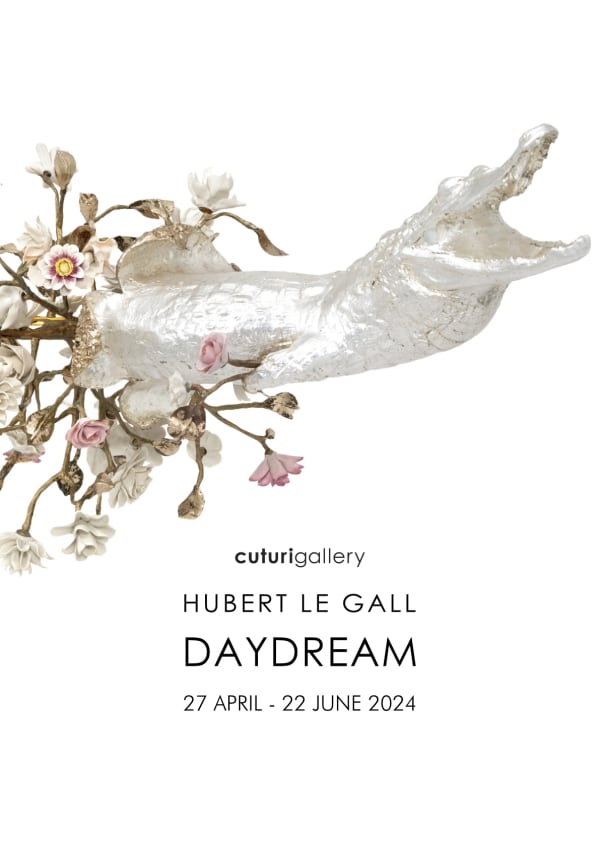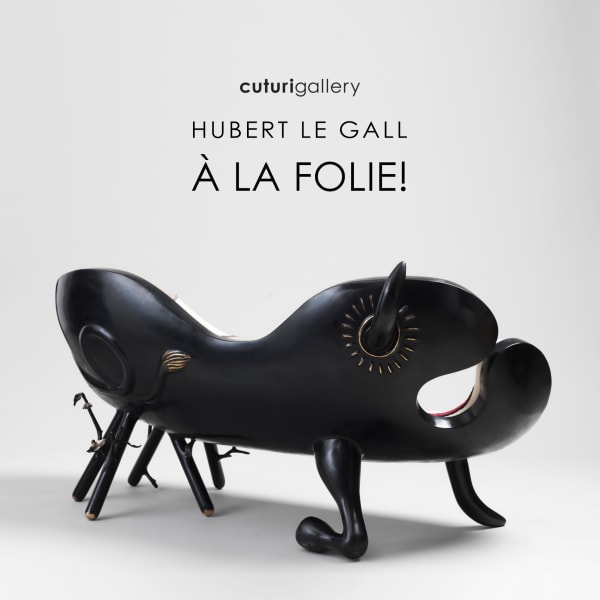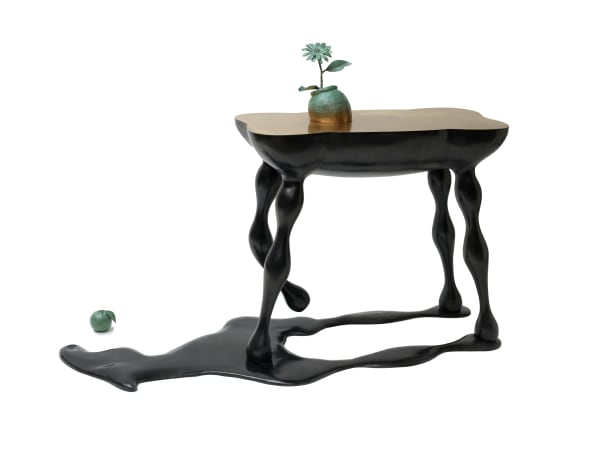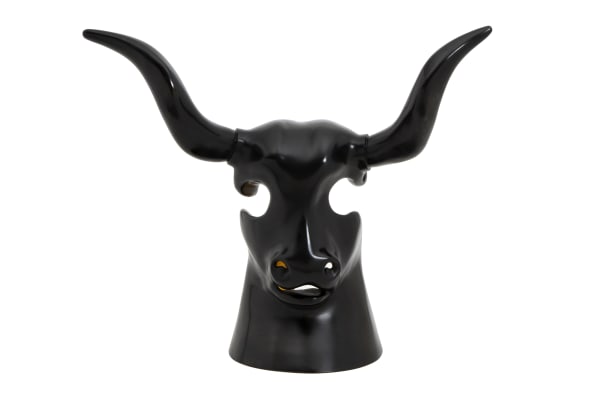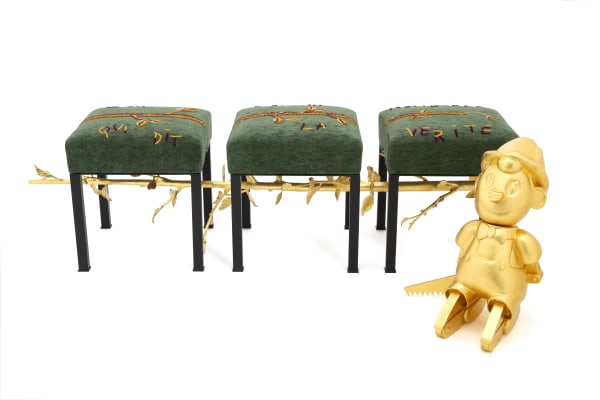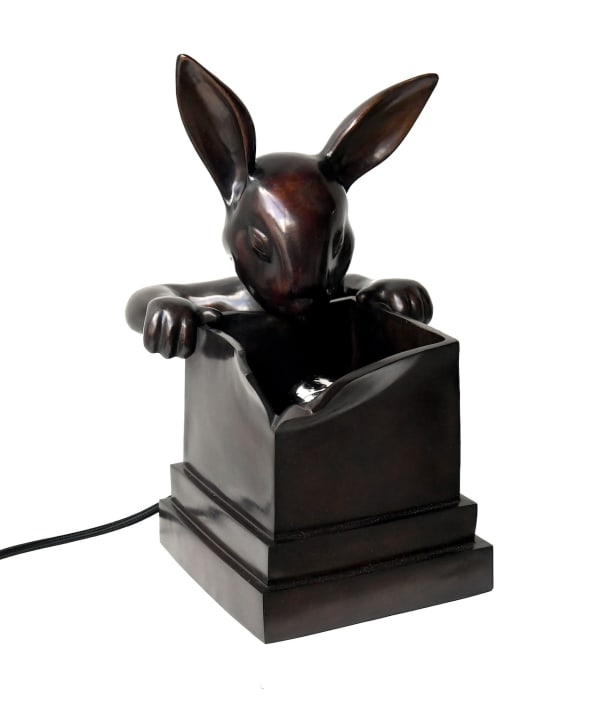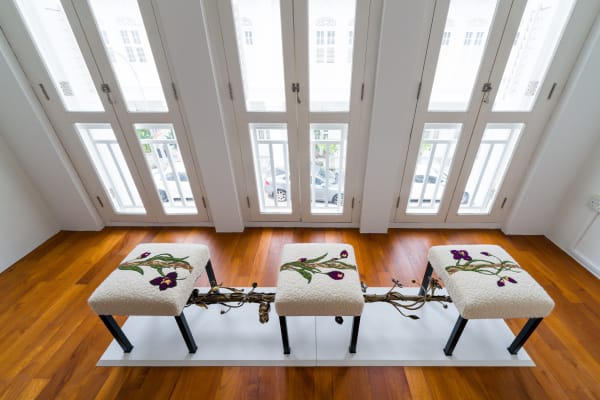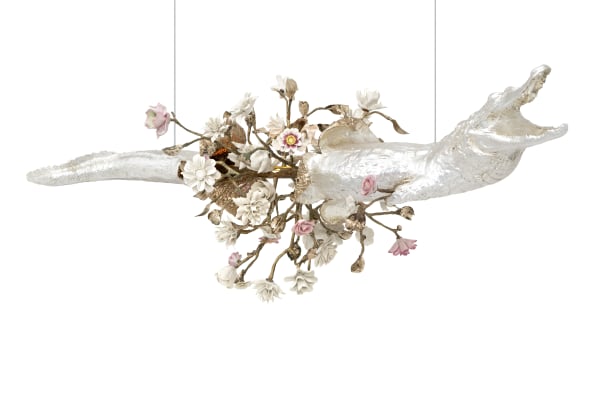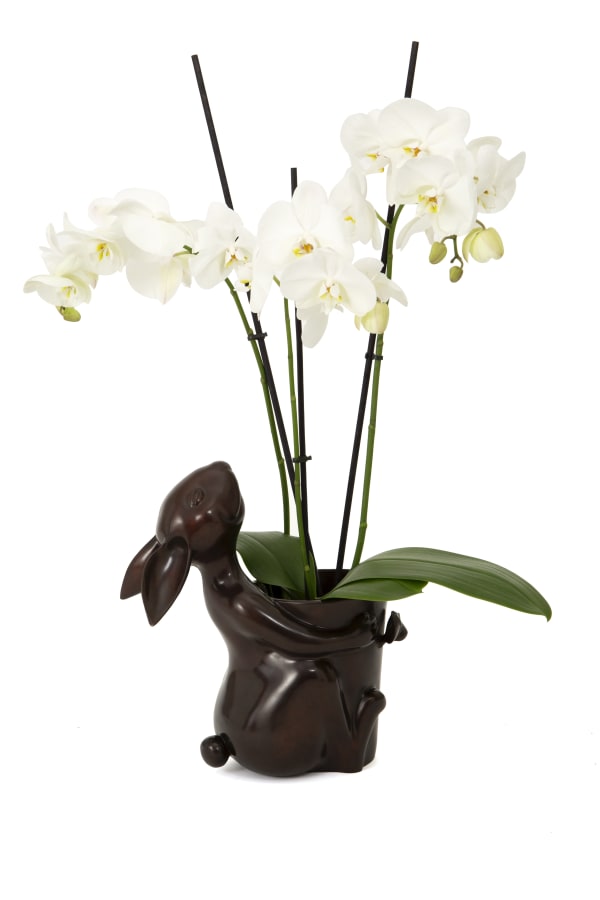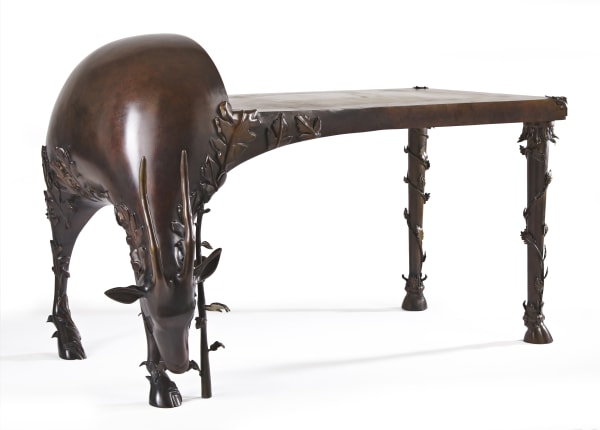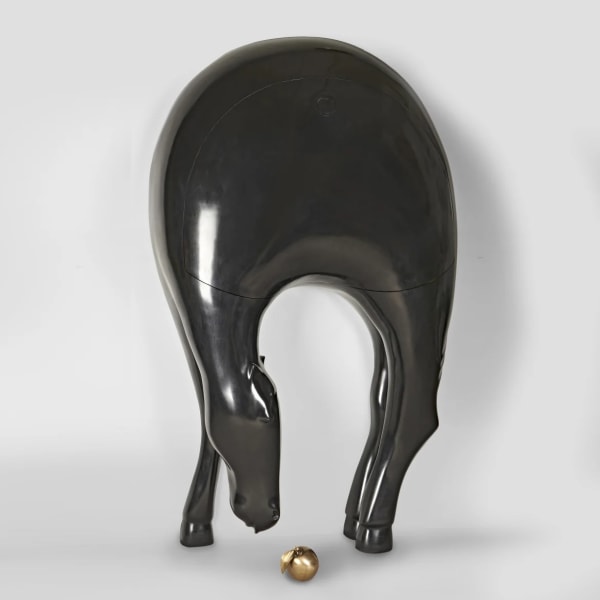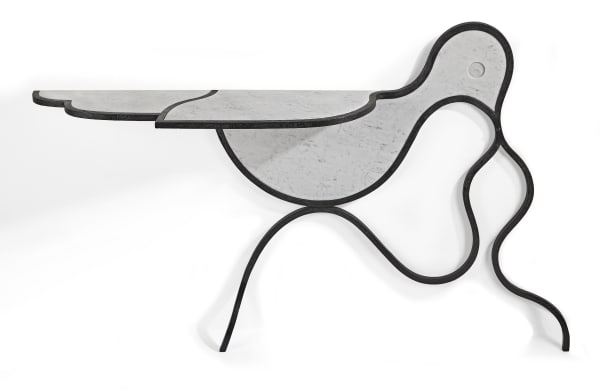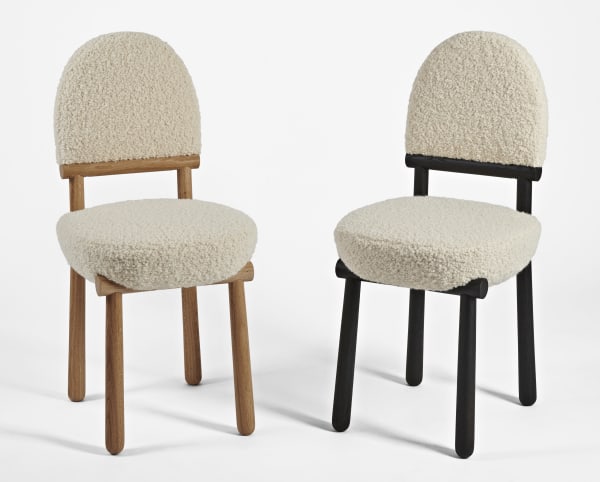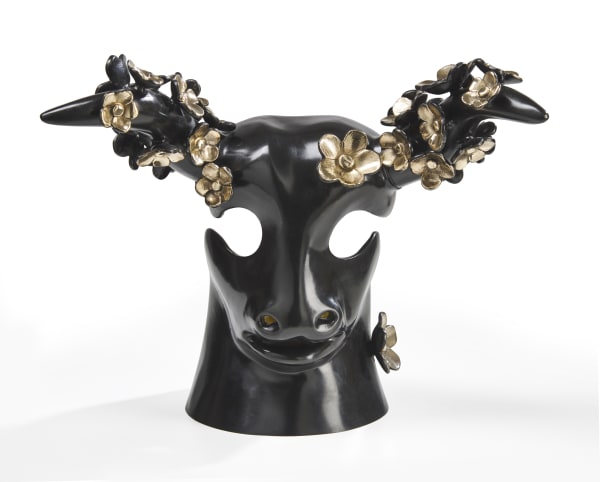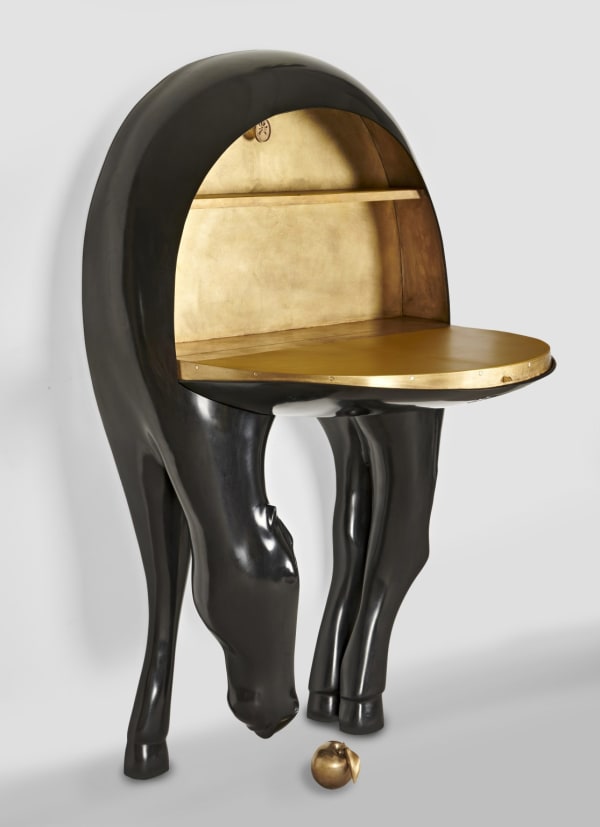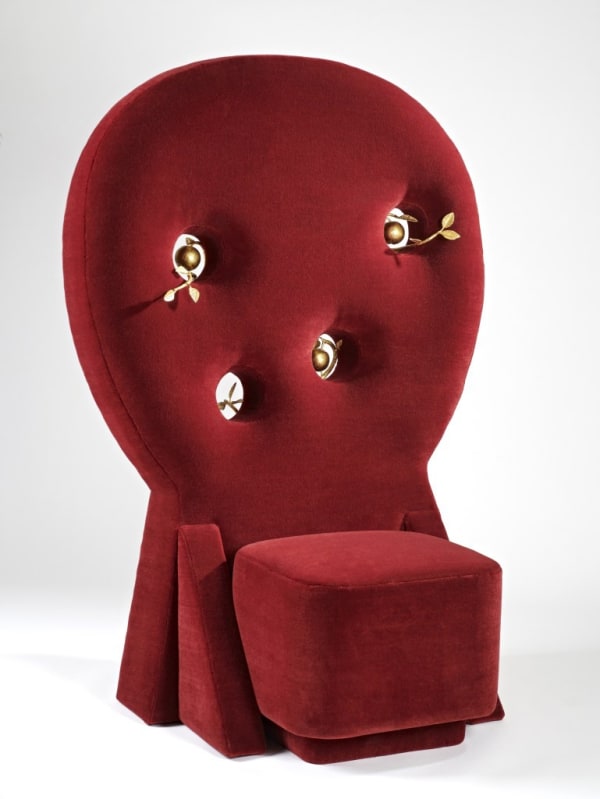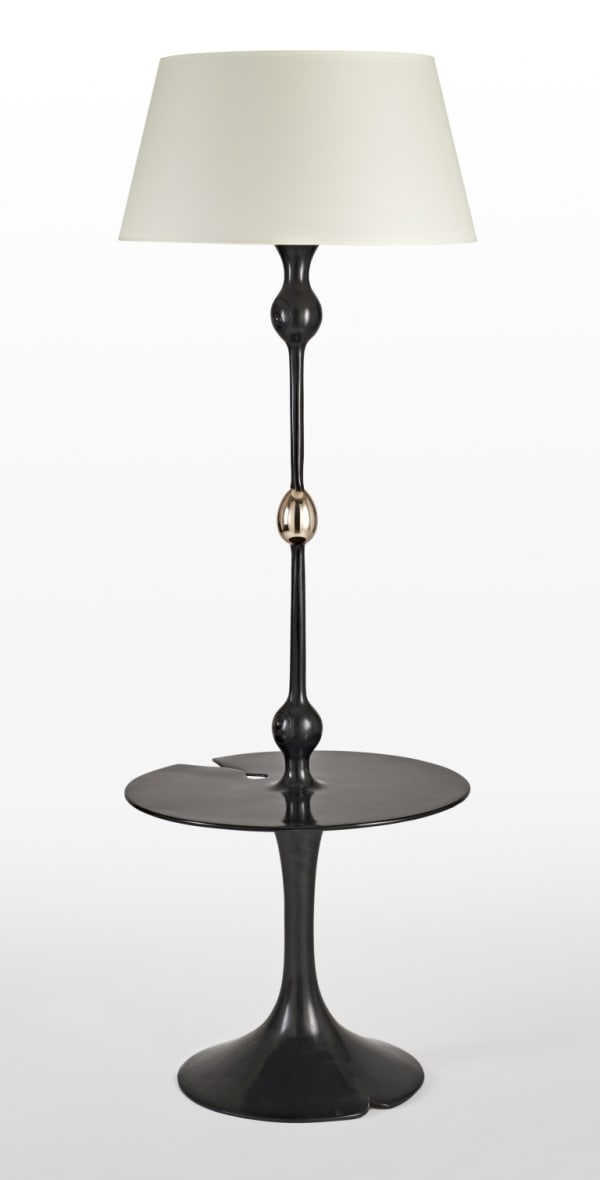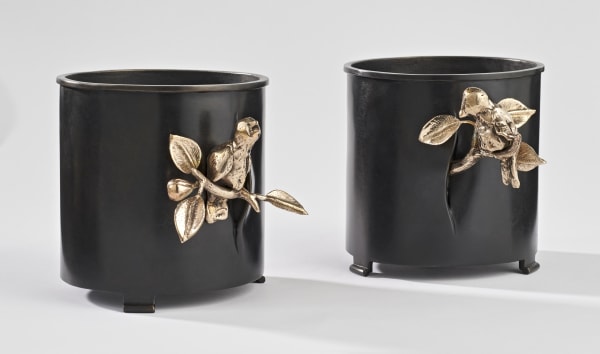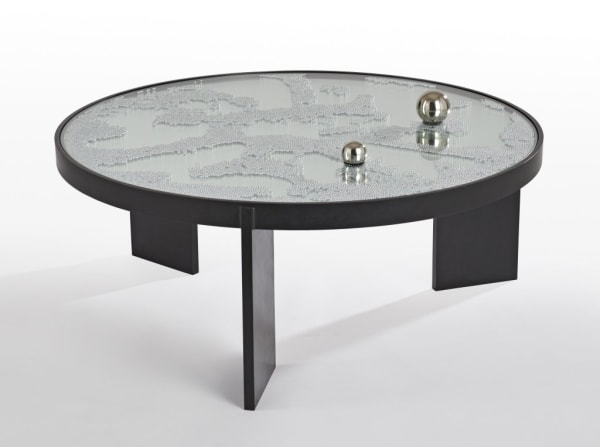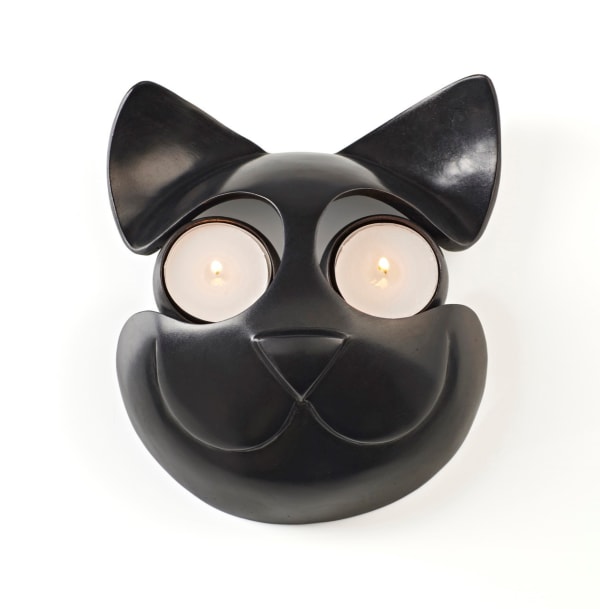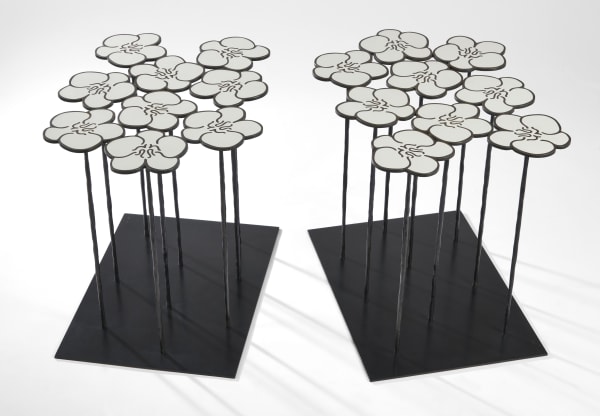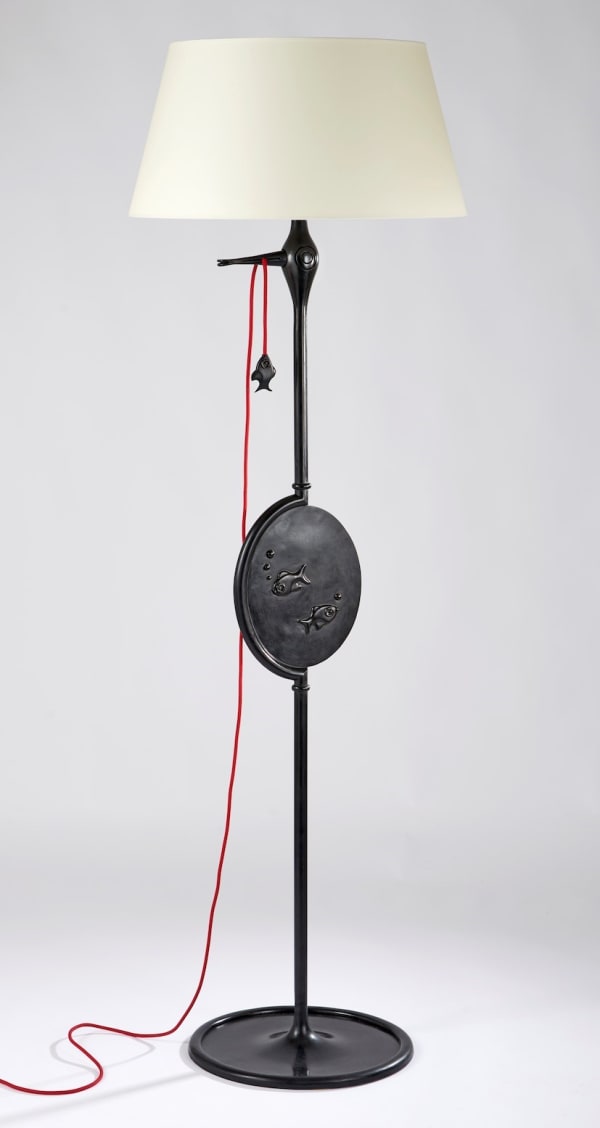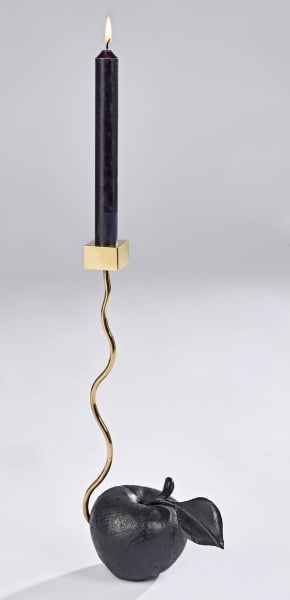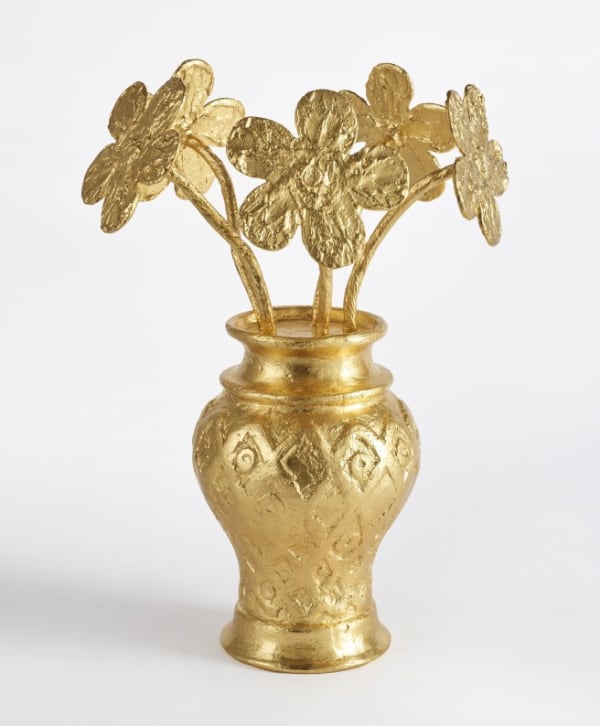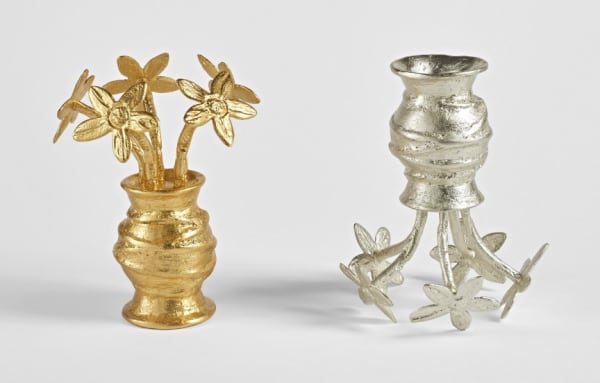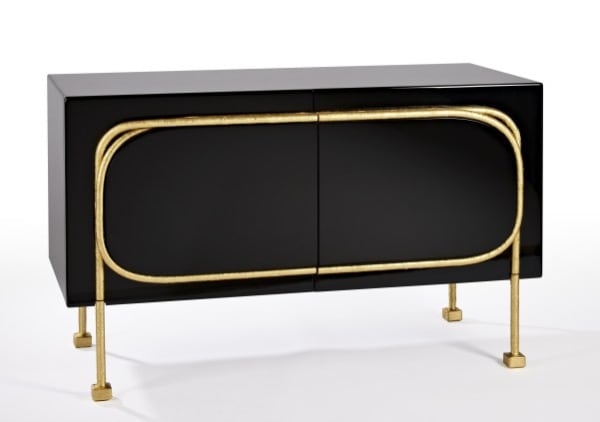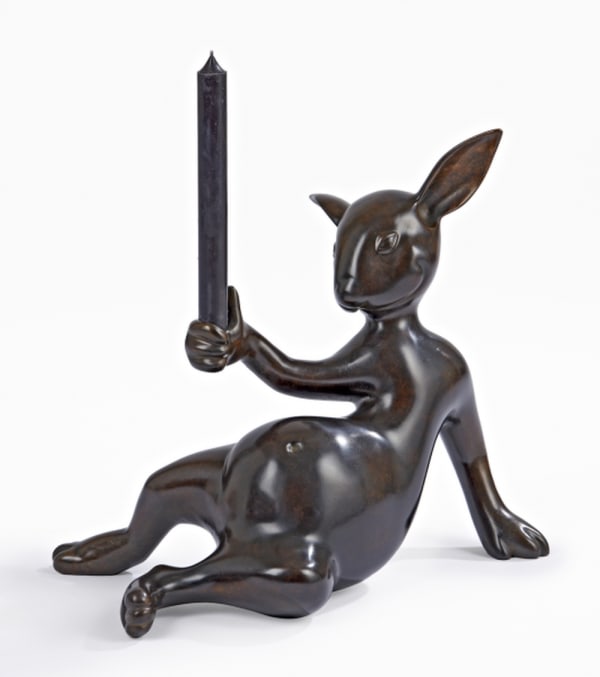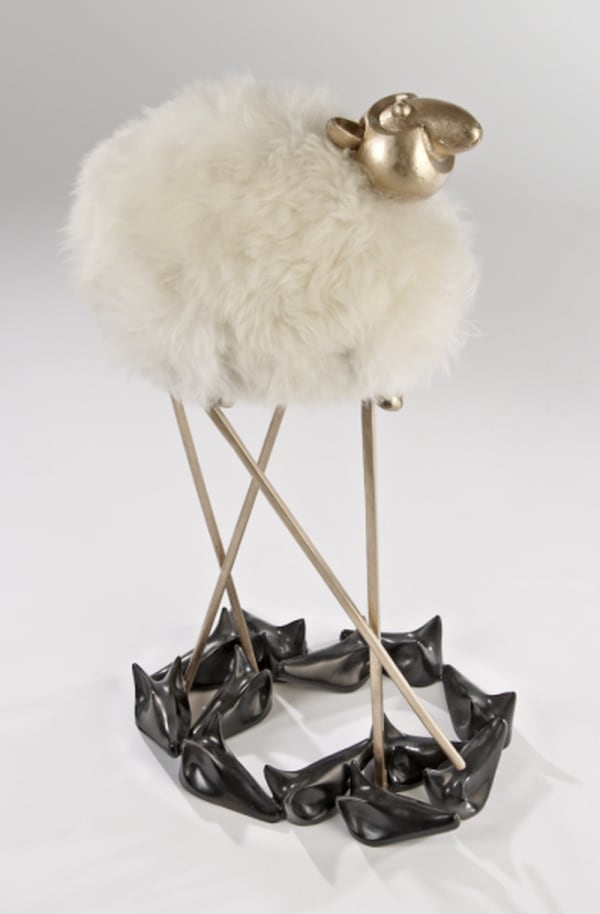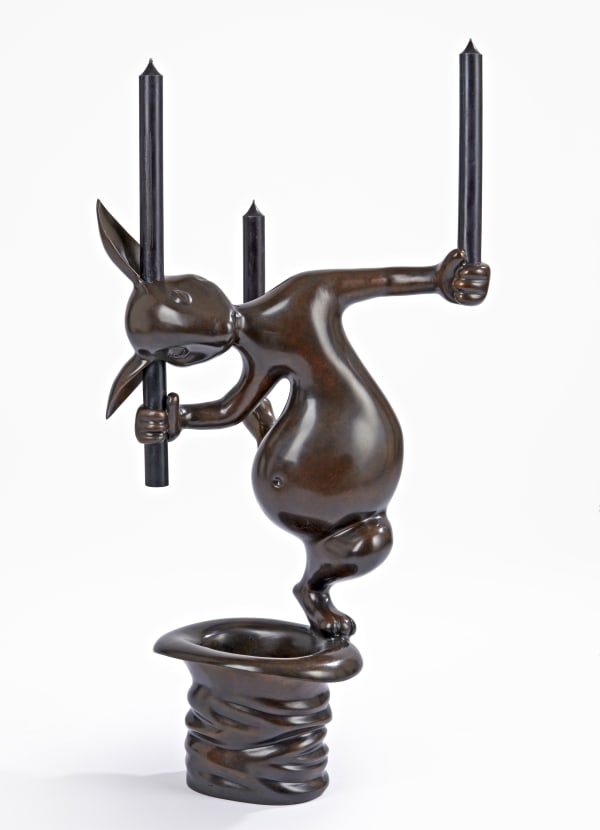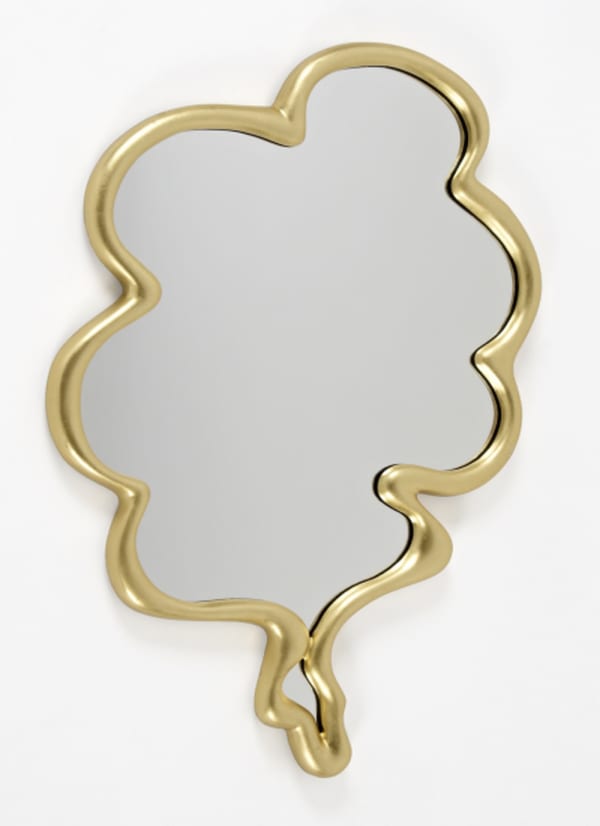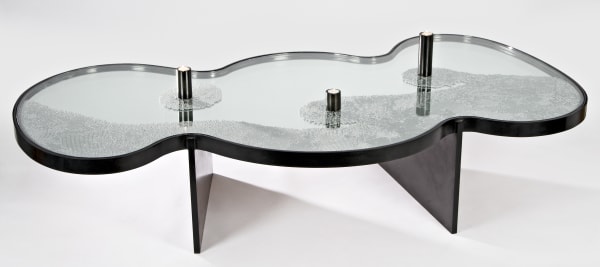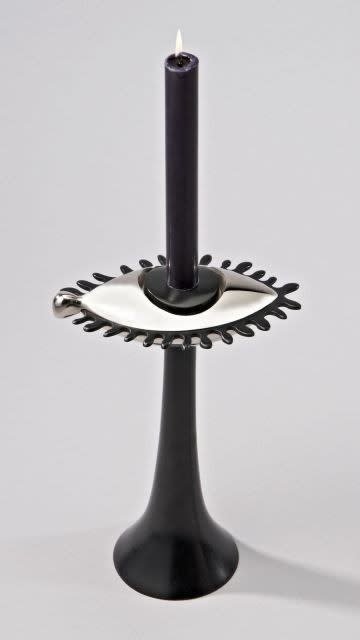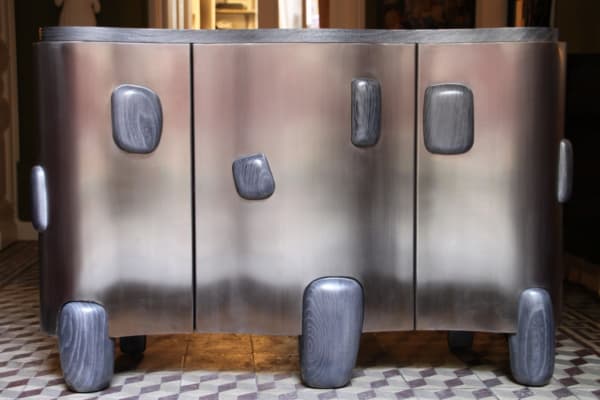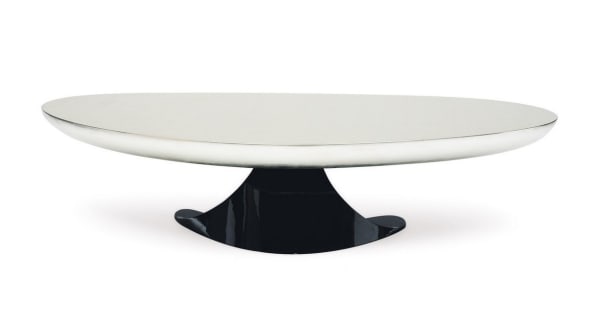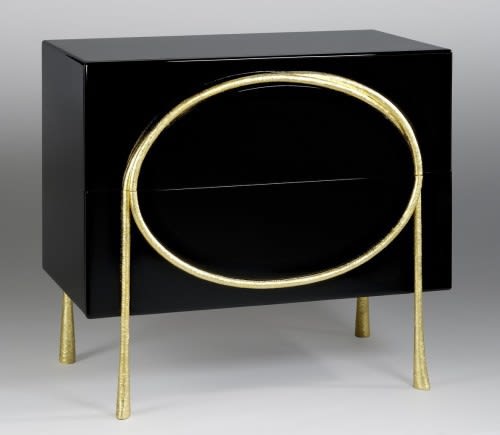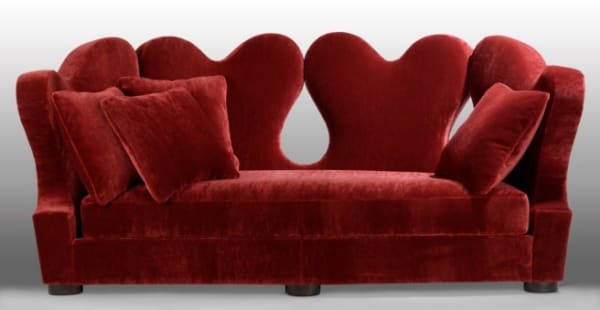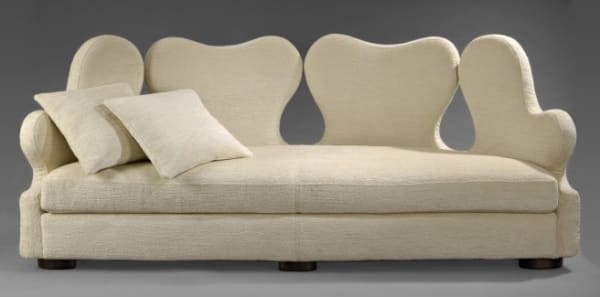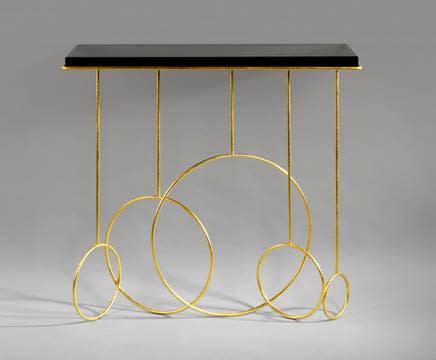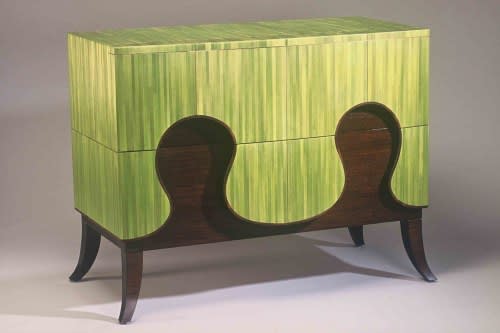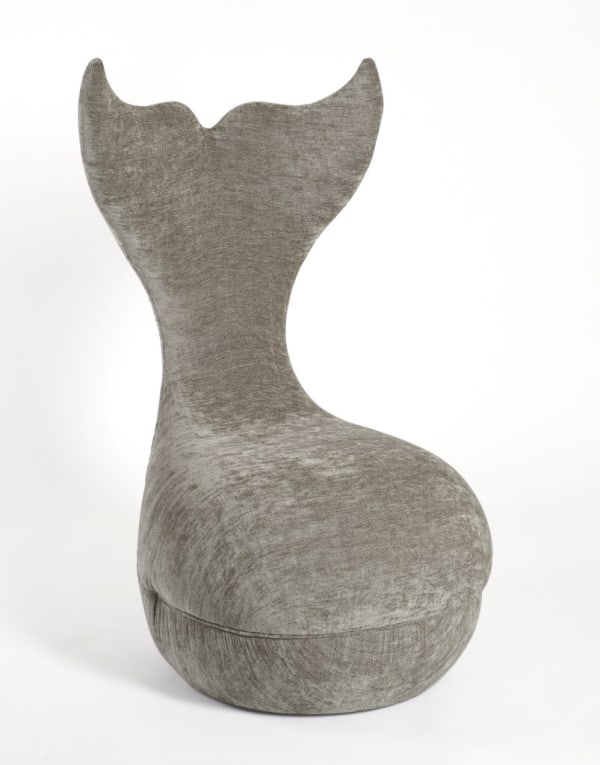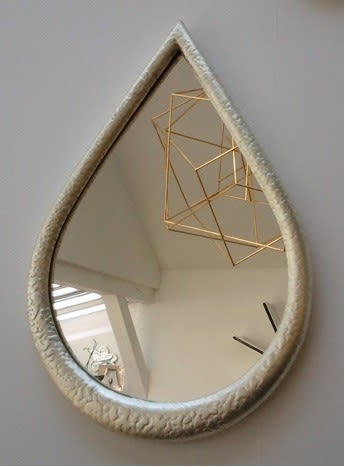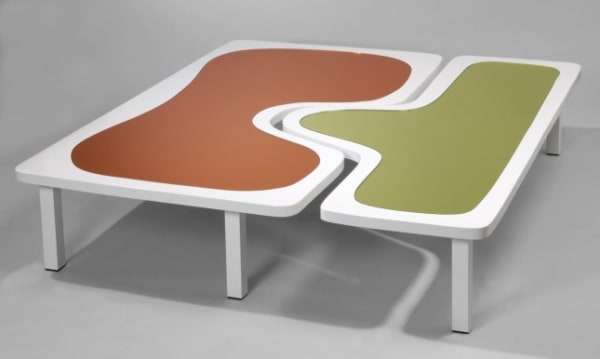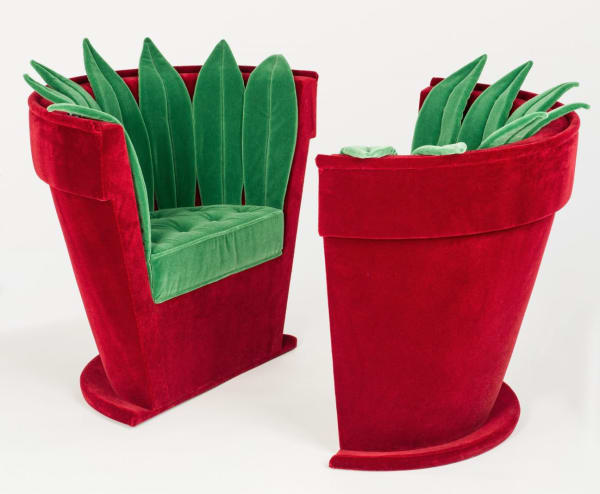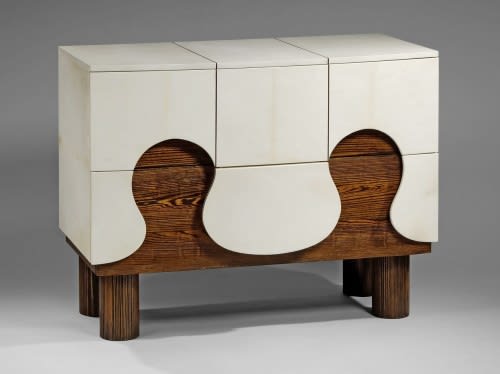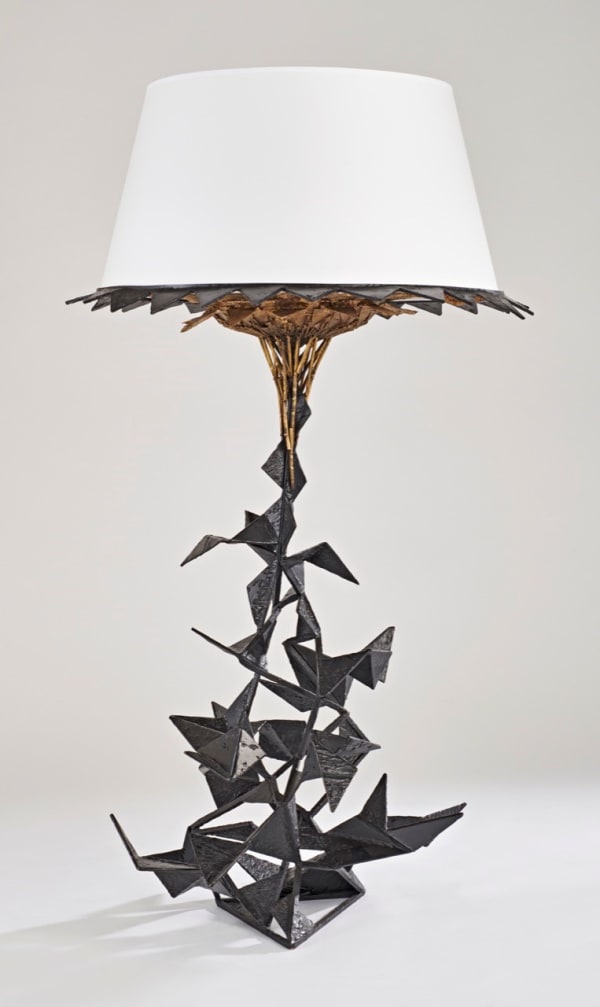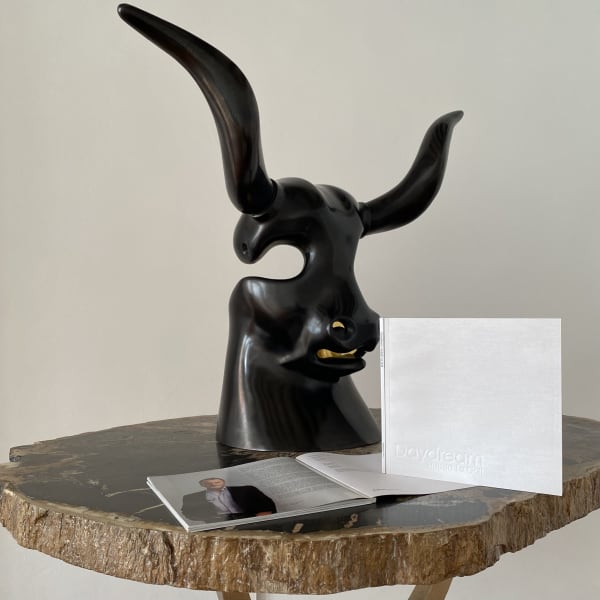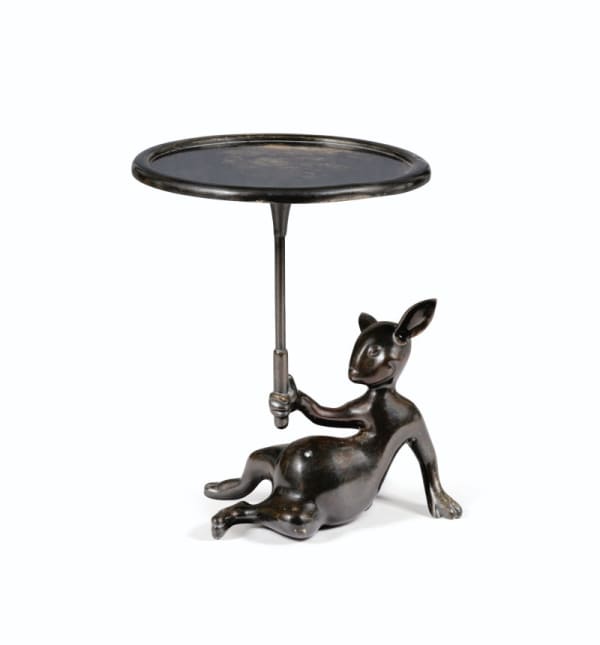Hubert Le Gall's work is a bold combination of sophistication and playfulness. He is a fixed star on the international design scene, he exhibits and sells his work globally.
Inspired by the likes of Salvador Dali, Jean Cocteau, the Surrealists and Max Ernst, Le Gall introduces humour and beauty into everyday life. When you step through the doors of French self-taught artist-designer Hubert Le Gall’s atelier in Montmartre in Paris, you feel as if you’ve stepped into Lewis Carroll’s Alice’s Adventures in Wonderland or a Dali painting, entering into a strange new world where everything has been turned upside down and nothing is what it seems. The vision is playful, the shapes unusual, the proportions oversized, the materials luxurious, and there’s always the recognizable hint of childhood. The works are at once familiar and unfamiliar: there are chamomile commodes, rabbit ear armchairs, dog lights, bull cabinets, sheep dressing tables, giraffe chimneys, raindrop mirrors and skull sculptures. There are even mice running up and down a room divider, Pinocchio who cut off his nose with a saw that has morphed into a leafy branch and stuck it into a console, foam bubbling out of an armoire and a chained yeti disguised as a table lamp.
Le Gall surrounds himself with creations stemming from his overflowing imagination, which lie somewhere between contemporary art and decorative object. Viewers are often left wondering if it’s a sculpture or a piece of furniture, only to realize that it really doesn’t matter in the end for Le Gall himself refuses to choose between the labels of artist and designer. He admits, “I don’t see myself as a designer because I have more an artistic approach than a design approach. But do I see myself as an artist? I don’t know because I make decorative art, I don’t paint. I always say that I am a creator of furniture. I am more an artist than a designer. That’s why I’m more interested in the world of art than the world of decoration.”
Having originally started in portraiture, Le Gall’s artistic leanings are evident in his furniture and object designs infused with humour and illusion, all rooted in a rigorous quality of execution and exquisite finishes. Taking a classic and adding a twist, his furniture stands outside of established conventions and speaks to the emotions, inviting viewers to reconsider their perception of it.
While borrowing freely from the art world, Le Gall also injects a functional dimension: Andy Warhol’s Flowers becomes a daisy table, Roy Lichtenstein’s Sunset becomes a bookshelf, Jean-Pierre Raynaud’s Pot becomes two comfy armchairs in the shape of a bisected flowerpot containing a green plant. Never working with established furniture manufacturers, he eschews mass production intrinsic to the design industry. Instead, he favours making objects in extremely small series of eight or 25 – echoing the craftwork of yesteryear when artisans made one-off objects – and taking a hands-on approach in their manufacture.
He explains, “It’s a choice that I made very early on to limit my work because what I’m doing is not necessarily design but something closer to sculpture, so I wanted to stay within numbering that is unique to sculpture. Also, when I was young, I was already selling objects in bronze that were pricey, so I told my clients it was because it was just a unique piece or series of eight. Creating rarity was my way to compensate for the fact that it was expensive. I made the right decision because today when things come back for sale at auction, it is because they are rare that they continue to sell well.”

ART SG 2025
Aisha Rosli, Faris Heizer, Hubert Le Gall, Khairulddin Wahab, Lionel Sabatté, Shen Jiaqi and more17 - 19 Jan 2025Art FairsRead more
Daydream
Hubert Le Gall27 Apr - 22 Jun 2024SingaporeRead more
Liminal
Hubert Le Gall, Khairulddin Wahab, Lionel Sabatté, Quentin Garel, Steven Low, Sukhburen Narankhuu and Wayan Upadana24 Feb - 6 Apr 2024SingaporeRead more
Abu Dhabi Art 2023
Hubert le Gall and Khairulddin Wahab22 - 26 Nov 2023Art FairsRead more
À la folie!
Hubert Le Gall9 - 27 Nov 2022LondonRead more
2020 Summer Show
Group Exhibition9 Jul - 2 Aug 2020SingaporeAs part of the gallery’s summer presentation, Cuturi Gallery is pleased to present a group exhibition showcasing an eclectic mix of artists, whose artistic practices span mixed media, sculpture and...Read more
 Juliette Moss Sconce , 2024
Juliette Moss Sconce , 2024 Romeo Moss Sconce, 2024
Romeo Moss Sconce, 2024 Branche Neige Van Gogh, 2024
Branche Neige Van Gogh, 2024 Mirror Le Bain de Diane, 2024
Mirror Le Bain de Diane, 2024 Daydream Console, 2024
Daydream Console, 2024 Masquerade, 2024
Masquerade, 2024 Pinocchio Bench: Art Is a Lie That Tells the Truth, 2024
Pinocchio Bench: Art Is a Lie That Tells the Truth, 2024 Léon Lamp, 2024
Léon Lamp, 2024 Vide Poche Léo, 2024
Vide Poche Léo, 2024 Whale Chair in Blue, 2024
Whale Chair in Blue, 2024 Orchid Bench, 2024
Orchid Bench, 2024 Maxou Armchair, 2023
Maxou Armchair, 2023 Isidore, Alfred et Oscar Pouffes , 2023
Isidore, Alfred et Oscar Pouffes , 2023 Branche Neige, 2023
Branche Neige, 2023 Calisto, 2023
Calisto, 2023 Chaos-crocodylus, 2023
Chaos-crocodylus, 2023 Pic Poc Lamp, 2023
Pic Poc Lamp, 2023 Allegra, 2023
Allegra, 2023 Cache-Pot Antoine, 2023
Cache-Pot Antoine, 2023 Romeo Floor Lamp, 2023
Romeo Floor Lamp, 2023 Vase Draft, 2023
Vase Draft, 2023 Vase Draft , 2023
Vase Draft , 2023 Mirabelles Nouvelles Mirror, 2022
Mirabelles Nouvelles Mirror, 2022 Zorbi et Zorba Candleholders, 2022
Zorbi et Zorba Candleholders, 2022 Fabiola Floorlamp, 2022
Fabiola Floorlamp, 2022 Panthéon Frissons Table, 2022
Panthéon Frissons Table, 2022 Janie Coffee Table, 2022
Janie Coffee Table, 2022 Esope Gueridon, 2022
Esope Gueridon, 2022 Pilou Console, 2022
Pilou Console, 2022 Pasiphaé (Bronze Version), 2022
Pasiphaé (Bronze Version), 2022 Antilope Mirror, 2022
Antilope Mirror, 2022 Mikro Vazo, 2022
Mikro Vazo, 2022 Astrocrokylus, 2022
Astrocrokylus, 2022 Pandora Jewellery Coffret, 2021
Pandora Jewellery Coffret, 2021 Pénélope et Argos Chair, 2020
Pénélope et Argos Chair, 2020 Liberty Candleholder, 2020
Liberty Candleholder, 2020 Athéna Tabouret, 2020
Athéna Tabouret, 2020 Ulysses' Ruse Sculpture, 2020
Ulysses' Ruse Sculpture, 2020 The Supplication of the Danaïdes Sculpture, 2020
The Supplication of the Danaïdes Sculpture, 2020 Virgile, 2020
Virgile, 2020 Pasiphaé, 2020
Pasiphaé, 2020 Secrétaire Pégase Desk, 2020
Secrétaire Pégase Desk, 2020 Picorette Console , 2019
Picorette Console , 2019 Spirus Mirror, 2019
Spirus Mirror, 2019 Gstaad Chairs, 2019
Gstaad Chairs, 2019 Passoda Gueridon, 2019
Passoda Gueridon, 2019 Cretan Bull Tealight Holder, 2019
Cretan Bull Tealight Holder, 2019 L’Éternel Printemps Cabinet , 2018
L’Éternel Printemps Cabinet , 2018 Pinocchio Cabinet , 2018
Pinocchio Cabinet , 2018 7 Chardons Candleholder, 2018
7 Chardons Candleholder, 2018 Anthévémis Buffet, 2018
Anthévémis Buffet, 2018 Secretary Cheval Desk, 2018
Secretary Cheval Desk, 2018 Eve Armchair , 2018
Eve Armchair , 2018 Maxou Armchair , 2018
Maxou Armchair , 2018 Hyppolite Floor Lamp, 2018
Hyppolite Floor Lamp, 2018 Passoda Floor Lamp, 2018
Passoda Floor Lamp, 2018 Zébulon, The Bubbler Floor Lamp, 2018
Zébulon, The Bubbler Floor Lamp, 2018 Oiseau Pot, 2018
Oiseau Pot, 2018 Solaire Frisson Table, 2018
Solaire Frisson Table, 2018 Orchids 10 Flowers Table, 2018
Orchids 10 Flowers Table, 2018 Max the Tealight Holder, 2017
Max the Tealight Holder, 2017 Orchids 2 x 9 Flowers Tables, 2017
Orchids 2 x 9 Flowers Tables, 2017 Orchids 18 Flowers Table, 2017
Orchids 18 Flowers Table, 2017 Pomone Pot, 2017
Pomone Pot, 2017 Ostrich Floor Lamp, 2016
Ostrich Floor Lamp, 2016 Zoa, The Fisherman Floor Lamp, 2016
Zoa, The Fisherman Floor Lamp, 2016 Pear Candleholder, 2016
Pear Candleholder, 2016 Apple Candleholder, 2016
Apple Candleholder, 2016 Dodger Pot, 2016
Dodger Pot, 2016 Vase Everso Louloudia - Grand Modèle, 2016
Vase Everso Louloudia - Grand Modèle, 2016 Odilon Sconce, 2016
Odilon Sconce, 2016 Foxy Gueridon , 2016
Foxy Gueridon , 2016 Olympia Gueridon , 2016
Olympia Gueridon , 2016 Vase Everso Louloudia - Petit Modèle, 2016
Vase Everso Louloudia - Petit Modèle, 2016 Skili Floor Lamp, 2015
Skili Floor Lamp, 2015 Pinocchio Lamp, 2015
Pinocchio Lamp, 2015 Commode Ferrière, 2014
Commode Ferrière, 2014 Creole Buffet , 2014
Creole Buffet , 2014 Melancolia Gueridon , 2014
Melancolia Gueridon , 2014 Pinocchio Floor Lamp, 2014
Pinocchio Floor Lamp, 2014 Grand Sonia Mirror, 2014
Grand Sonia Mirror, 2014 Good Dog Floor Lamp, 2013
Good Dog Floor Lamp, 2013 Odilon Candleholder, 2013
Odilon Candleholder, 2013 Olympia Candleholder, 2013
Olympia Candleholder, 2013 Remus Mirror (Moon Gold), 2013
Remus Mirror (Moon Gold), 2013 Playful Fish Gueridon, 2013
Playful Fish Gueridon, 2013 Belgian Frisson Table, 2012
Belgian Frisson Table, 2012 Sheep Jumping Wolf Lamp, 2012
Sheep Jumping Wolf Lamp, 2012 Epoca Winter Lamp, 2012
Epoca Winter Lamp, 2012 Lucien Candleholder, 2012
Lucien Candleholder, 2012 Placide, The Rabbit Chair, 2012
Placide, The Rabbit Chair, 2012 Pinocchio Console , 2012
Pinocchio Console , 2012 Petit Nougat Mirror, 2012
Petit Nougat Mirror, 2012 Smoke Mirror, 2012
Smoke Mirror, 2012 Table Frissons, 2012
Table Frissons, 2012 Loopy Mirror, 2012
Loopy Mirror, 2012 Méga Météora Mirror, 2012
Méga Météora Mirror, 2012 Météora Mirror, 2012
Météora Mirror, 2012 Météorien Mirror, 2012
Météorien Mirror, 2012 Mahè Tortue Des Mers Mirror , 2012
Mahè Tortue Des Mers Mirror , 2012 Pétille Lamp - Patina, 2011
Pétille Lamp - Patina, 2011 Mirette Candleholder , 2011
Mirette Candleholder , 2011 Milou Mirror, 2010
Milou Mirror, 2010 Vase Vice Verso Nouveau Micro , 2010
Vase Vice Verso Nouveau Micro , 2010 Mahjong Buffet 3 Doors, 2010
Mahjong Buffet 3 Doors, 2010 Rio Table, 2009
Rio Table, 2009 Vase Tête du Poète , 2009
Vase Tête du Poète , 2009 Agathe Mirror, 2008
Agathe Mirror, 2008 Caviar Mirror, 2008
Caviar Mirror, 2008 Champagne Mirror, 2008
Champagne Mirror, 2008 Mirabelles Mirror, 2008
Mirabelles Mirror, 2008 Romulus Mirror, 2007
Romulus Mirror, 2007 Commode Créole, 2007
Commode Créole, 2007 Deminino Mirror, 2006
Deminino Mirror, 2006 Babeth Sofa, 2006
Babeth Sofa, 2006 Chiko Sofa, 2006
Chiko Sofa, 2006 Chiffonier Igloo, 2006
Chiffonier Igloo, 2006 Polyèdres Pendant Light, 2006
Polyèdres Pendant Light, 2006 Diamant Mirror, 2006
Diamant Mirror, 2006 Nénuphar Table, 2006
Nénuphar Table, 2006 Serpentine Lights, 2005
Serpentine Lights, 2005 Sonate Console , 2005
Sonate Console , 2005 Commode Azur, 2005
Commode Azur, 2005 Commode Goutte d’herbe, 2005
Commode Goutte d’herbe, 2005 Arbre Pétrifié Gueridon, 2005
Arbre Pétrifié Gueridon, 2005 Whale Chair, 2004
Whale Chair, 2004 Summer 2 x 9 Flowers , 2004
Summer 2 x 9 Flowers , 2004 Tania Mirror, 2004
Tania Mirror, 2004 Domino Mirror, 2004
Domino Mirror, 2004 Trèfle Chair, 2004
Trèfle Chair, 2004 Grande Goutte Mirror, 2004
Grande Goutte Mirror, 2004 L’été Sera Chaud Coffee Table, 2004
L’été Sera Chaud Coffee Table, 2004 Nougat Mirror, 2004
Nougat Mirror, 2004 Mi Lamp, 2003
Mi Lamp, 2003 Sunset Bookshelf , 2003
Sunset Bookshelf , 2003 Mi Mirror, 2003
Mi Mirror, 2003 Taureau Cabinet, 2002
Taureau Cabinet, 2002 Commode Ondine, 2002
Commode Ondine, 2002 Cavale Console , 2001
Cavale Console , 2001 Flower Pot Chair, 1998
Flower Pot Chair, 1998 Mouse Door Holder
Mouse Door Holder Commode Mont Blanc
Commode Mont Blanc Grand Tournesol Lamp
Grand Tournesol Lamp

Things To Do In Singapore: Emerging Artist Faris Heizer’s New Solo Exhibition Opens
Keng Yang Shuen, Female Magazine, September 9, 2024
Hubert Le Gall injects fairytale wonder into showstopping furniture
Russell Marino Soh, The Edge Singapore, May 15, 2024
Furniture or sculpture? Le Gall blurs the line
The French designer’s solo exhibition at Cuturi Gallery features some of his best piecesHelmi Yusof, The Business Times, May 9, 2024
Free events at French festival Voilah! to reach more audiences
Ong Sor Fern, The Straits Times, April 10, 2024
A guide to collecting and curating art, with exclusive tips from esteemed gallerists and collectors
Yaiza Canopoli, Tatler, March 22, 2024
Arts Picks: Kids’ theatre shows in Malay and Mandarin, Cuturi’s sculpture show and The Face Of Jizo
Ong Sor Fern, The Straits Times, February 22, 2024
Interior design trends 2024: How to furnish and decorate your home next year
Yaiza Canopoli, Tatler Asia, December 13, 2023
Hubert Le Gall Presents His First Solo UK Exhibition
Arts and Collections, November 11, 2022
Can Smell Be an Artistic Medium? A Perfume Expert Teamed Up With Joana Vasconcelos and Other Artists to Make ‘Olfactory
Anna Sansom, Artnet, June 17, 2021
5 Art Exhibitions In Singapore To See In July 2020
Amelia Yeo, Singapore Tatler, July 6, 2020
Strong sales as France restarts live auctions
ANNA SANSOM, THE ART NEWSPAPER, May 22, 2020
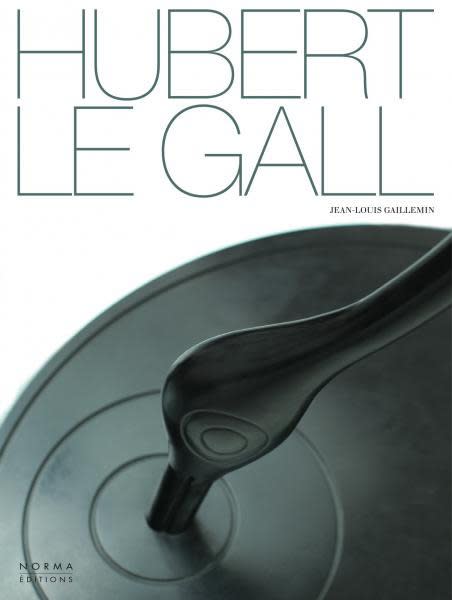
Catalogue Raisonné
Hubert Le Gall Jean-Louis Gaillemin, 2013Hard Cover, 208 pagesRead more
Publisher: Editions Norma
ISBN: 2915542503
Dimensions: 24 x 2 x 31.5 cm
Fabula
Hubert Le Gall Hubert Le Gall, Pascaline Noack, Patt Morrison, Dany Sautot, 2018Hard Cover, 290 pagesRead more
Publisher: Flammarion
ISBN: 208020386X
Dimensions: 31 x 4 x 39.5 cm

Daydream by Hubert Le Gall
April 27, 2024Cuturi Gallery is proud to announce Hubert Le Gall 's exhibition booklet titled 'Daydream '. Featuring a selection of works, including pieces exclusively made for...Read more
A Greek Fantasy by Hubert Le Gall
June 11, 2021This beautiful and unique exhibition by the talented artist Hubert Le Gall was meant to take place in May 2020 and run through the summer....Read more
New Auction Record set for Hubert Le Gall
May 10, 2021Hubert Le Gall (b. 1961, Lyon, France) is an artist-designer who's work is a bold combination of sophistication and playfulness. You probably have encountered some...Read more
Subscribe to our Newsletter
* denotes required fields
We will process the personal data you have supplied in accordance with our privacy policy (available on request). You can unsubscribe or change your preferences at any time by clicking the link in our emails.



